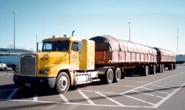Shipping and Logistics

Trucking Reports Higher Demand and Rates
Written by Sandy Williams
September 8, 2020
Spot rates continued to rise for all truck categories in September. Spot load posts were up 1.4 percent in the week ending Sept. 6 versus the last week of August, while spot truck posts increased 1.6 percent on the DAT Loadboards. Hurricane Laura-related disruptions added volumes to the market pushing up spot prices, especially for dry van freight. The average line haul rate of $2.22 per mile was the highest on record for dry vans, said DAT.
National flatbed rates ended August at $2.37 per mile compared to $2.07 in June. Volumes at the end of the month pushed the national flatbed load-to-truck ratio to 36.68, jumping from 28.26 in the week ending Aug. 16.
Flatbed freight volumes demand moderated slightly last week, ending on Sept. 6 at a national load-to-truck ratio of 36.50. Flatbed spot rates rose 1.8 percent to $32.37 per mile.
Diesel fuel prices stayed unchanged last week at $2.43 per gallon on average.
Trucking companies report higher freight demand as manufacturers and retailers replenish stock. Increases were reported by firms that provide less-than-truckload (LTL) shipments (multiple shipments on the same truck).
“With the industrial economy continuing to rebound month over month and robust activity in the TL [truckload] market, our sense was that LTL demand continued to accelerate as the quarter has progressed,” said Stephens Inc. analyst Jack Atkins in a research note last week. “Looking ahead, we expect the strength in the broader freight market to persist through the end of the year.”
Higher demand drove an increase in trucking employment numbers last month. According to the Bureau of Labor Statistics, 8,800 truck drivers were added in August as drivers returned to work after pandemic layoffs
“The unadjusted for-hire trucking employment tally for this August, 1,466,800, is still 85,800 jobs below year-ago employment for trucking, and 36,600 jobs below this year’s peak of 1,503,400 jobs in February,” said JOC.com’s trucking editor William Cassidy. “That is a contributing factor to the truckload and less-than-truckload (LTL) capacity shortfall shippers are suffering as the U.S. economy attempts to pull out of recession.”

Sandy Williams
Read more from Sandy WilliamsLatest in Shipping and Logistics

US Great Lakes iron ore cargoes down notably through May
The Lake Carriers' Association reported a considerable decline in monthly iron ore shipments from US ports on the Great Lakes.

Wittbecker: West Coast port congestion
What's going on in West Coast ports?

Wittbecker: Mexico invests in port capacity despite US tariff troubles
The Mexican government aims to transform Manzanillo into the largest seaport in Latin America, capable of processing some 10 million TEU (20-foot equivalent units) per year by 2030. It is already Mexico's largest port and the third largest in Latin America, handling nearly 4 million 20-foot containers in 2024.

Wittbecker on Aluminum: When do the tariffs reach Main Street?
Containers sailing from China in April are down 15%-20% and Hapag Lloyd says their future bookings transpacific are down 30%.

Wittbecker on Aluminum: US-China trade war clobbers cross-Pacific trade
Container shipping lines have sharply increased blank sailings on Transpacific routes in response to escalating trade tensions between the US and China.
